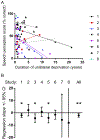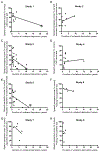Duration of unilateral auditory deprivation is associated with reduced speech perception after cochlear implantation: A single-sided deafness study
- PMID: 30486762
- PMCID: PMC6335158
- DOI: 10.1080/14670100.2018.1550469
Duration of unilateral auditory deprivation is associated with reduced speech perception after cochlear implantation: A single-sided deafness study
Abstract
Objective: Examine the relationship between duration of unilateral deafness and speech perception outcomes after cochlear implantation in adults with single-sided deafness.
Methods: A systematic review of PubMed articles containing individual speech perception and duration of deafness data from single-sided deaf adults. Studies were selected for detailed review and duration of deafness and speech perception outcomes were extracted, with speech scores reported as percent correct. A linear regression as a function of study and length of deafness was performed.
Results: A statistically significant negative effect of duration of unilateral deafness on speech perception was found, but there was substantial uncertainty regarding the strength of the effect.
Discussion: Existing data make it difficult to either support or reject a hard 5- or 10-year unilateral auditory deprivation limit on cochlear implant (CI) candidacy for patients with single-sided deafness. This is because the totality of available data are consistent with a very small effect, perhaps negligible in practical terms, and just as consistent with a very large effect. Regardless of effect size, the present results have important basic implications. They suggest that unilateral sound deprivation may have a deleterious effect on auditory processing even though more central parts of the auditory system have continued to receive input from a contralateral normal ear.
Conclusions: Speech perception scores in SSD patients are negatively correlated with duration of deafness, but the limited amount of data from cochlear implant users with long-term single-sided deafness leads to substantial uncertainly, which in turn precludes any strong clinical recommendations. Further study of SSD CI users with long-term deafness will be necessary to generate evidence-based guidelines for implantation criteria in this population.
Keywords: Cochlear Implant; Single-sided Deaf; Speech Perception.
Figures


Similar articles
-
Cochlear Implantation in Children With Single-Sided Deafness: A Systematic Review and Meta-analysis.JAMA Otolaryngol Head Neck Surg. 2021 Jan 1;147(1):58-69. doi: 10.1001/jamaoto.2020.3852. JAMA Otolaryngol Head Neck Surg. 2021. PMID: 33151295 Free PMC article.
-
Binaural Perception in Single-Sided Deaf Cochlear Implant Users with Unrestricted or Restricted Acoustic Hearing in the Non-Implanted Ear.Audiol Neurootol. 2018;23(3):187-197. doi: 10.1159/000490879. Epub 2018 Oct 23. Audiol Neurootol. 2018. PMID: 30352440
-
Single-Sided Deafness: Impact of Cochlear Implantation on Speech Perception in Complex Noise and on Auditory Localization Accuracy.Otol Neurotol. 2017 Dec;38(10):e563-e569. doi: 10.1097/MAO.0000000000001520. Otol Neurotol. 2017. PMID: 29135878
-
Single Sided Deaf Cochlear Implant Users in the Difficult Listening Situation: Speech Perception and Subjective Benefit.Otol Neurotol. 2018 Oct;39(9):e803-e809. doi: 10.1097/MAO.0000000000001963. Otol Neurotol. 2018. PMID: 30199498
-
Cochlear implantation in single-sided deafness for enhancement of sound localization and speech perception.Curr Opin Otolaryngol Head Neck Surg. 2012 Oct;20(5):393-7. doi: 10.1097/MOO.0b013e328357a613. Curr Opin Otolaryngol Head Neck Surg. 2012. PMID: 22886035 Review.
Cited by
-
Expanding unilateral cochlear implantation criteria for adults with bilateral acquired severe sensorineural hearing loss.Eur Arch Otorhinolaryngol. 2019 May;276(5):1313-1320. doi: 10.1007/s00405-019-05358-z. Epub 2019 Feb 27. Eur Arch Otorhinolaryngol. 2019. PMID: 30810818 Free PMC article.
-
Selective attention decoding in bimodal cochlear implant users.Front Neurosci. 2023 Jan 11;16:1057605. doi: 10.3389/fnins.2022.1057605. eCollection 2022. Front Neurosci. 2023. PMID: 36711138 Free PMC article.
-
The impact of cochlear implantation on quality of life and psychological status in single-sided deafness or asymmetric hearing loss with tinnitus and influencing factors of implantation intention: a preliminary study.Eur Arch Otorhinolaryngol. 2024 Jan;281(1):95-105. doi: 10.1007/s00405-023-08086-7. Epub 2023 Jun 28. Eur Arch Otorhinolaryngol. 2024. PMID: 37378727
-
Lateralization Pattern of the Weber Tuning Fork Test in Longstanding Unilateral Profound Hearing Loss: Implications for Cochlear Implantation.Audiol Res. 2022 Jun 21;12(4):347-356. doi: 10.3390/audiolres12040036. Audiol Res. 2022. PMID: 35892662 Free PMC article.
-
The impact of etiology and duration of deafness on speech perception outcomes in SSD patients.Eur Arch Otorhinolaryngol. 2019 Dec;276(12):3317-3325. doi: 10.1007/s00405-019-05644-w. Epub 2019 Sep 18. Eur Arch Otorhinolaryngol. 2019. PMID: 31535291
References
-
- Arndt S, Aschendorff A, Laszig R, Beck R, Schild C, Kroeger S, et al. (2011). Comparison of pseudobinaural hearing to real binaural hearing rehabilitation after cochlear implantation in patients with unilateral deafness and tinnitus. Otol Neurotol, 32(1), 39–47. doi: 10.1097/MAO.0b013e3181fcf271 - DOI - PubMed
-
- Arndt S, Laszig R, Aschendorff A, Schild C, Beck R, Kroeger S, et al. (2011). The University of Freiburg Asymmetric Hearing Loss Study. Audiology and Neuro-Otology, 16(suppl 1), 3–25.
-
- Balkany TJ, Hodges AV, Eshraghi AA, Butts S, Bricker K, Lingvai J, et al. (2002). Cochlear implants in children--a review. Acta Otolaryngol, 122(4), 356–362. - PubMed
Publication types
MeSH terms
Grants and funding
LinkOut - more resources
Full Text Sources
